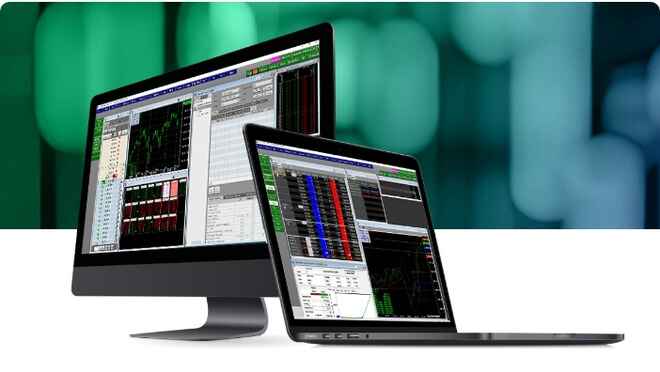Dow Jones Industrial Average (DJIA) futures are one of the most popular and widely traded futures contracts in the world – and for good reason. They give you broad exposure to the stock market and many attractive benefits, including diversification, leverage, and hedging opportunities. Successfully executing a Dow Jones Industrial Average futures strategy requires a foundation of basic knowledge. We’ve created this DJIA futures guide for beginners to help you learn how they work, what factors can affect their price, as well as the benefits and risks of trading them.
DJIA Futures Guide: How Do They Work?
DJIA futures are contracts that allow traders to speculate on the future value of the Dow Jones Industrial Average, a stock market index composed of 30 large publicly traded companies in the US. DJIA futures are standardized contracts that specify the quantity, price, and expiration date of the contract. They are traded on futures exchanges, and their price is determined by market demand and supply. DJIA futures trading requires a margin deposit, and contracts can be settled through physical delivery or cash settlement. DJIA futures provide traders with a way to gain exposure to the DJIA index and trade on its future value, with the potential for profits and losses based on the movement of the index.
What Are the Benefits of Trading DJIA Futures?
- DJIA futures provide exposure to a diverse range of large US companies, which can help spread risk across a range of different industries and sectors.
- Futures trading allows traders to control a large amount of underlying assets with a small amount of capital, which can magnify gains (and losses).
- DJIA futures can be used to hedge against market volatility, providing a way to protect against losses in other investments.
- DJIA futures are traded on highly liquid futures exchanges, which can make it easier to enter and exit trades quickly.
- Futures markets are highly transparent, with real-time price quotes and order books that allow traders to see the full depth of the market.
What Are the Risks Associated with Trading DJIA Futures?
- Futures markets can be highly volatile, with large swings in price that can lead to significant gains or losses.
- While leverage can magnify gains, it can also magnify losses. Traders can lose more than their initial investment if the market moves against them.
- Futures trading involves a counterparty risk, as traders are exposed to the credit risk of the exchange or broker through which they are trading.
- DJIA futures are subject to market risk, which can be influenced by a range of factors such as economic indicators, political events, and global market conditions.
- Futures trading requires margin, which can be subject to margin calls if the trader’s account falls below the required margin level. This can result in the trader having to deposit additional funds or risk having their position liquidated.
- While DJIA futures are highly liquid, there may be instances where the market becomes illiquid, making it difficult to enter or exit positions at the desired price.
How Do You Read and Interpret DJIA Futures Quotes?
DJIA futures quotes are displayed in a standard format that includes the symbol for the futures contract, the current price, and the change in price from the previous trading day. The symbol for DJIA futures is usually “YM,” followed by a code that represents the expiration month and year. For example, “YM-06/21” would represent a contract expiring in June 2021. The price quote for DJIA futures is based on the current value of the DJIA index, multiplied by a factor of $10. Traders can interpret DJIA futures quotes by monitoring the current price and change in price, and using technical analysis to identify potential support and resistance levels.
What Are the Contract Specifications for DJIA Futures, Including Tick Size and Contract Size?
Contract Size
The contract size for DJIA futures is $10 times the current value of the Dow Jones Industrial Average index. For example, if the DJIA index is trading at 30,000 points, the notional value of one DJIA futures contract would be $300,000.
Tick size
The tick size for DJIA futures is 1 point, which is equivalent to $10. This means that each point move in the DJIA index results in a $10 gain or loss in the value of the futures contract.
Expiration
DJIA futures contracts expire on the third Friday of the expiration month, which is typically the month following the delivery month. For example, the expiration month for a June contract would be July.
Hours
DJIA futures trade on the CME Globex electronic trading platform from Sunday evening through Friday afternoon, with a break from 4:15 pm to 5:00 pm Central Time each day.
Margin
The margin requirements for DJIA futures vary depending on the broker and market conditions, but typically range from $5,000 to $15,000 per contract.
What Factors Can Affect the Price of DJIA Futures?
Prices of DJIA futures are sensitive to a wide range of factors. We believe you should consider some of the following potential market movers when making an investment:
- Economic indicators such as GDP, inflation, and employment data can have a significant impact on the stock market and the price of DJIA futures.
- The earnings reports of individual companies in the DJIA index can affect investor sentiment and the price of DJIA futures.
- Changes in interest rates can affect borrowing costs and economic growth, which can in turn affect the stock market and the price of DJIA futures.
- Political instability, international conflicts, and other geopolitical events can create uncertainty and affect investor sentiment, which can impact the price of DJIA futures.
- The overall mood of the market, as reflected in investor sentiment and market trends, can have a significant impact on the price of DJIA futures.
- Natural disasters such as hurricanes, earthquakes, and floods can disrupt supply chains, damage infrastructure, and affect the stock market, which can impact the price of DJIA futures.
What Are the Tax Implications of Trading DJIA Futures?
Profits from futures trading are generally taxed as capital gains, either short-term or long-term, depending on the holding period of the futures contract. Short-term capital gains are taxed at the trader’s ordinary income tax rate, while long-term capital gains are taxed at a lower rate. Losses from futures trading can be used to offset gains from other investments or up to $3,000 of ordinary income per year. Unused losses can be carried forward to future years. 60% of any gains or losses are taxed at the long-term capital gains rate and 40% are taxed at the short-term capital gains rate, regardless of the holding period of the contract. Traders must be aware of the wash sale rules, which prevent traders from realizing losses on a security and immediately repurchasing the same security to benefit from the loss. The rules apply to futures trading as well as other types of securities trading.
What Are the Differences Between Trading DJIA Futures and Other Types of Futures Contracts?
DJIA futures are based on the Dow Jones Industrial Average, which tracks the stock prices of 30 large publicly traded companies in the US. Other futures contracts may be based on commodities, currencies, interest rates, or other assets. DJIA futures have a contract size of $10 times the current value of the DJIA index. Other futures contracts may have different contract or tick sizes or tax/margin requirements based on the underlying asset.
How Do You Choose a Futures Broker for Trading DJIA Futures?
There are a few key characteristics we believe you should look for when choosing a broker:
- Regulatory compliance
- Reasonable fees and commissions
- An advanced trading platform
- Strong customer support
- The right account types
- Robust cybersecurity and reliability
- Sterling reputation
How RJO Futures Can Help with DJIA Futures Trading
RJO Futures checks all of the above seven boxes. We offer the industry’s best mix of advanced trading tools, support from professionals and expansive account types and features. Combine that with a peerless reputation and commitment to compliance and security, and you’ll find no better partner to help you succeed with DJIA futures trading. We hope you enjoyed this beginner’s guide to DJIA futures and we urge you to reach out to RJO today.


